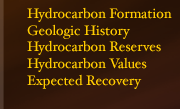
Environmental Implications - Decomposers
Likely effects from oil drilling
At this time, more detailed soil profile descriptions and soil climate data are needed for more accurate characterizations of patterns and net change in decomposition. However, the big picture implies that “environmental changes may have little impact on plant productivity unless average nutrient availability also changes” (Reynolds etc. al). This statement emphasizes the importance of decomposer species in any given ecosystem. Since they control the nutrient availability to an environment, they control not only plant productivity, but the competition that consequently occurs between plants for the nutrients, which affects evolution (according to survival of the fittest), and in turn the nutrition of herbivores and the carnivores that feed on the herbivores, etc. In essence, the entire food web of an ecosystem depends upon the availability of nutrition.
That said, the impact of road dust to decomposer species is as follows:
The influence of road dust results in higher soil pH levels (moving along the scale from acidic to basic), lower soil moisture, and greater thaw depth; although there are yet to be experimental studies of the impact on decomposer species specifically, the combination of the previously mentioned conditions when applied to simulations and past studies have shown that “soil enzyme activities in surface organic materials were found to be affected by dust loading: Activity increased rapidly with increased distance from the road” (Reynolds etc. al).
Even so, the biggest effects to decomposer species are likely to be those caused by changes in soil moisture. Reynolds etc. al found that “areas with moist tundra where water in channeled (water tracks) have higher vascular productivity and nitrogen availability than areas that do not.” Basically, decomposition rates are higher and nutrient uptake is easier. Yet, without moving water—i.e. under more stagnant conditions—wet soils relate to low nitrogen availability due to the anaerobic, decomposition inhibiting circumstances (Reynolds etc. al).
One of the problems that arise in evaluating the effects of disturbance in the Arctic is that there is a major lack of information describing the dynamic response of ecosystems to altered hydrological regimes and accompanying change in water quality. Therefore, it is my opinion that before conclusions concerning the impact of specific development strategies can be drawn, more experiments need to be performed.
Furthermore, in reference to decomposer species only, most of the impacts that I have discussed tend to operate on a more local scale. They would likely not affect an ecosystem as a whole unless there were many such local areas subjected to those impacts.
Reference:
1. Sarah J. Woodin & Mick Marquiss. (1997). Ecology of Arctic Environment





